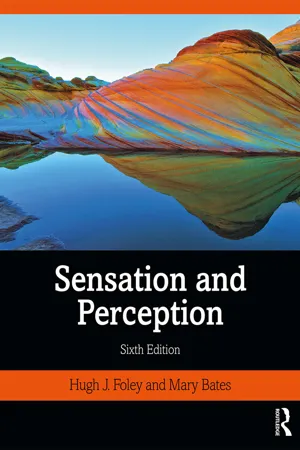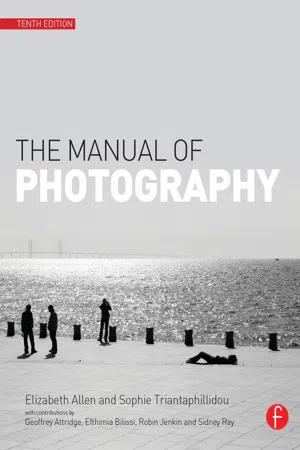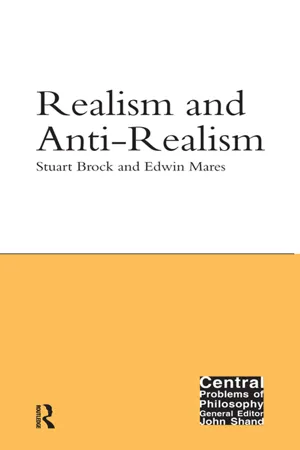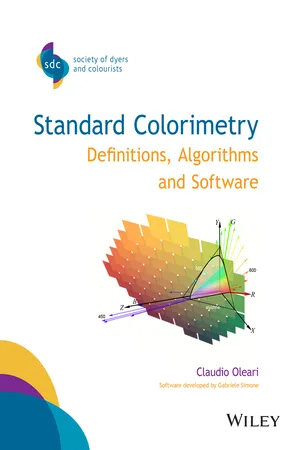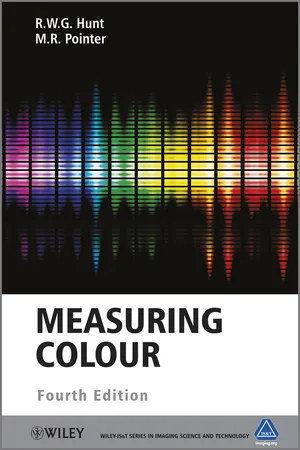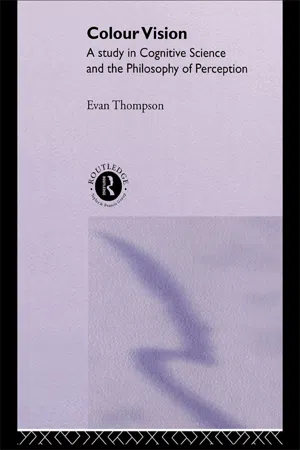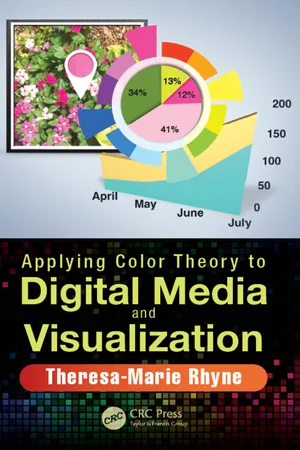Physics
The Nature of Colour
"The Nature of Colour" refers to the physical and perceptual properties of light that give rise to the sensation of color. In physics, color is understood as the result of the interaction between light, objects, and the human visual system. This interaction involves the absorption, reflection, and transmission of light, as well as the perception of different wavelengths as distinct colors.
Written by Perlego with AI-assistance
Related key terms
Related key terms
1 of 4
Related key terms
1 of 3
12 Key excerpts on "The Nature of Colour"
- eBook - ePub
- Hugh J. Foley(Author)
- 2019(Publication Date)
- Routledge(Publisher)
In addition to its evolutionary consequences, color perception plays important roles in our everyday lives. As a result, the perception of color has been a consistently popular topic for researchers. In this chapter, we’ll first focus on the physical aspects of color and color mixing. We’ll next review and expand on material about the visual system introduced earlier in the text, along with a discussion of theories of color perception. We’ll also look at individual differences in color vision before discussing various color phenomena.Nature of Color
An object’s color, as we typically use the term, has several components. Three terms are used to describe our perception: hue, saturation, and lightness. As we discussed in Chapters 3 and 4 , a physical dimension generally determines each of these qualities. As indicated in Chapter 4 , the intensity of the light source determines much of your experience of brightness. As illustrated in Table 7.1 , wavelength primarily determines an object’s hue, purity basically determines saturation, and the amount of light reflected basically determines lightness.Let us first examine hue , which is the psychological reaction to wavelengths ranging from about 400 nm (seen as the hue violet) to about 700 nm (seen as the hue red). Hue is a perception; out in the world, we find only light of many different wavelengths and no hues at all. Thus, red (or any other hue) is in your head.One person who understood that distinction was the famous British scientist Sir Isaac Newton (1643–1727). Newton completed his undergraduate career at Trinity College, Cambridge, in the summer of 1665. To avoid the plague, Newton returned to his home in a rural area of Lincolnshire County. Apparently, he put his time at home to good use, developing theories of calculus and gravity in addition to his work on the nature of light.At that time, prisms were novelty items sold at fairs, so people were well aware of the spectrum revealed by the prism (Mollon, 2003 - eBook - ePub
The Color Management Handbook for Visual Effects Artists
Digital Color Principles, Color Management Fundamentals & ACES Workflows
- Victor Perez(Author)
- 2023(Publication Date)
- Focal Press(Publisher)
Section I Optics and Perception of ColorPassage contains an image
1 Elements of Optics
DOI: 10.4324/b23222-2As visual effects artists we observe reality not just through our eyes but most importantly through the lens of a camera. This fact set the rules of the game to start digging into the journey of light to be perceived as color. Understanding the very process of perception of color is key to comprehend the system we use to capture color. Therefore, I decided to start our journey of color management far from the management part and closer to the color. We need to get familiar with lights, cameras, supports, lenses and ultimately with the physiognomy of the most wonderful organ in our body: the eye. I believe that in order to understand the process of color acquisition and management, it is important to put into context the very fundamental notions about physics of light, color and how this is captured. Everything is within a historical context.This chapter explores those basics to start building your color knowledge from the ground up.Light
From a physics point of view, the first question that pops in our mind when we need to approach color is very simple: “What is color?” However, since color is intrinsically related to light, before finding an answer to that question maybe we should understand one of the fundamental properties of light: wavelength.Light is much more than we can observe, light itself is an electromagnetic radiation, and it behaves, contemporarily, as both particles (“packages” of energy: photons) and waves, with a huge span of wavelengths inside every single ray of light. Actually, there is more light that we cannot see than the fraction that we can (Figure 1.1 ).The wavelength is a characteristic of any kind of wave. It is the distance over which the shape of a wave repeats, measured on any given point on the wave.Figure 1.1 Wavelength of a sinusoidal waveThe figure above illustrates this concept. A given sinusoidal wave1 – right now we do not need to care about the distance or the value in this example, just the mere concept of wavelength. If we select a point in the wave, for instance where y reaches its maximum value – let’s name this point A – and we continue moving in the x axis until next time y repeats the same value as in point A – let’s name this other point B – the distance between A and B - eBook - ePub
- Elizabeth Allen, Sophie Triantaphillidou(Authors)
- 2012(Publication Date)
- Routledge(Publisher)
Chapter | 5 | Introduction to colour science Sophie Triantaphillidou All images © Sophie Triantaphillidou unless indicated. INTRODUCTION This chapter is an introduction to the fundamentals of colour description, measurement, evaluation and appearance. Knowledge of theories and current practices related to these topics is paramount in comprehending how colour is recorded, reproduced and managed in imaging media, subjects that will be introduced in later chapters. Colour is evaluated in different ways. Physicists describe variations in the intensities of wavelengths of visible radiation. Colorimetrists describe the amounts of reference primaries which, when additively mixed, match a particular reference light. Sensory scientists describe an observer’s response as a result of stimulating their visual sensory mechanism. There is no single meaning or definition attached to the word ‘colour’. Although the word is understood by everyone, if we are asked to define colour, the answer is not so obvious. Further, if asked to describe a particular colour, for instance ‘blue’, it is difficult to do so without using an example, such as ‘blue is the colour of the sea’. Regardless of how we interpret the word, colour exists because of the way our visual system interprets light of different wavelengths. It is not merely a physical phenomenon but a psychophysical phenomenon (i.e. a sensory response resulting from a physical stimulus) or simply an aspect of visual perception. Working with colour imaging has made the classification of colour and its description in terms of numbers essential. Several systems have been devised over the years for the purpose. The Commission Internationale de l’Éclairage (CIE, or International Commission of Illumination) methods are widely adopted and will be the main focus of this chapter - eBook - ePub
- Stuart Brock, Edwin Mares(Authors)
- 2014(Publication Date)
- Routledge(Publisher)
With this in mind, there is no better place to start than with a discussion of the philosophy of colour. We have evolved to perceive the colours of objects, and no wonder. Without this ability, we could not see anything at all. It is by virtue of seeing the colours of objects that we can see their contours, edges and shapes. Even visibly transparent objects can be seen only in virtue of seeing and contrasting the colours of other objects in the immediate environment. And so, given that so much of our knowledge of the external world comes via the modality of sight, colour perception must be one of the most important human adaptations, or so it might be thought.Philosophers and scientists who work in this area are in general agreement that objects appear coloured, and that we base many of our beliefs about the world on those appearances. But they are also in general agreement that it is extremely difficult to fit colours – at least when conceived of as intrinsic properties of objects – into any reasonable metaphysical picture of the world. There is a sharp division on the question as to whether physical objects are really coloured and, if they are, what the nature of these colour properties is. Among the options canvassed in recent years, the most prominent are that the colours of objects are microphysical properties,1 reflectance properties,2 the extensions of response-dependent concepts,3 non-physical properties4 or nonexistent properties.5 In order to appreciate the merits of each alternative, though, we must first draw attention to a number of assumptions that will play an important role in what follows.First, we shall concentrate only on one dimension of colour: hue. We shall all but ignore the other dimensions along which colours may vary, such as saturation and brightness. Moreover, we shall only focus on the colours of surface properties of objects. We shall pay no attention to the colours of after-images, light sources, diffuse objects such as the sky, and volumes such as jelly and wine. These restrictions are meant to simplify our topic, thereby making it a little more tractable. They are not intended to give the misleading impression that the subject matter is simpler than it really is. Indeed, part of our aim is to illustrate how complex these issues really are even after such simplifying assumptions have been made.6 - eBook - ePub
- Tom Porter, Byron Mikellides, Tom Porter, Byron Mikellides(Authors)
- 2019(Publication Date)
- Taylor & Francis(Publisher)
In general terms, colour does not exist without light, which is radiant energy that manifests itself in the form of the visible spectrum of sunlight. Without the eye and brain of an observer, these rays do not in themselves constitute colour. As Sir Isaac Newton explained in his Opticks (1704), ‘The rays are not coloured. In them there is nothing else than a power to stir up a sensation of this or that colour.’ 2 In short, the perception of colour depends upon three essential factors: (1) the spectral energy distribution of the light (including the conditions under which the colour is perceived); (2) the spectral characteristics of the object, with respect to absorption, reflection and transmission of light; and (3) the activity and sensitivity of the eye and brain (Figure 2.1). The light source In physical terms, light is simply the name given to a narrow band of the energy constantly radiating from the sun. Newton, by placing a glass prism in the path of a beam of sunlight, observed how the beam divided itself into the band of colours he called the spectrum. We now know that the colours of the spectrum vary in wavelength (the distance between the crest of one energy wave and the next) and that the visible range of wavelengths extends from about 400 to 750 nanometres (billionths of a metre). Using a second prism, in 1665, Newton demonstrated that white light is obtained when all the colours of the spectrum are recombined into a single beam. Observers such as Thomas Young (1807) later found that white light could be obtained by mixing red, green and blue beams only, and that all other colours could be obtained by mixing these three lights in different proportions - eBook - ePub
Standard Colorimetry
Definitions, Algorithms and Software
- Claudio Oleari(Author)
- 2015(Publication Date)
- Wiley(Publisher)
4 Perceptual Phenomenology of Light and Colour4.1 Introduction
Often, visual experience has led humans to consider mistakenly colour as the exclusive property of objects and light sources, without thinking that the visual experience exists only because a light flux enters the eye and activates the visual system of the observer.Isaac Newton1 wrote:“For the rays to speak properly are not coloured. In them there is nothing else than a certain power and disposition to stir up a sensation of this or that colour.”According to Newton, colours are sensations and colour sensations are not measurable physical quantities, but attributes of the visual sensations and therefore these entities are purely subjective and incommunicable. The sensation that every other observer experiences is unknown, although everybody calls that colour sensation with the same name. At the moment, science does not have any tools able to ‘observe’ and measure the last stage of the visual process that human beings experience as perception and regard consciousness. In addition, the human being communicates colour sensations with language and the colour specification is then made with the names that distinguish the colour sensations. This verbal specification concerns observer individuality and therefore does not have the objective value required by science, but certainly is a way for knowledge of the human visual system.Only measurements on the colour stimuli are considered objective, while the attributes of perceived colours are subjective. In this chapter perceived colours are considered in relation to verbal language and to perceptive and physical phenomena in order to understand mainly whether a colour ordering is possible. Moreover, perceptive phenomena produced by different colour stimuli simultaneously present in the visual field are considered.4.2 Perceived Colours, Categorization and Language
The distinction between colour sensation and colour perception is a debated item. Consider the following two definitions as a guide, not as an answer to the debate: - eBook - ePub
- Anders Steinvall, Sarah Street(Authors)
- 2022(Publication Date)
- Bloomsbury Academic(Publisher)
When the CoC met a decade later to write an updated report, many members rejected the sensation-based account in favor of the perceptual account. But while Katz’s version of the perceptual account provided a better description of color experience, it achieved this at the cost of increased complexity. As Katz notes, “objects on the one hand are blue, yellow, red, etc., and on the other hand sparkle, shine, glitter, etc.” (1935: 33). Faced with specifications of color far more complex than simply hue, saturation, and brightness, the chairman of the report, L. A. Jones, noted, “the Committee did not react favorably” (1953: 8). The committee debated these issues for several years with little progress; as Jones later recalled: “this discussion continued for more years than the chairman likes to remember, and a stalemate between the physical and psychological viewpoints seems to have been reached” (9). Jones finally proposed a psychophysical definition: “color consists of the characteristic of light […] of which a human observer is aware through the visual sensations which arise from stimulation of the retina” (221). This psychophysical definition represented a notable attempt to tie together the diverging views: it acknowledged the role of sensations in color vision but treated them as the means by which we perceive properties of external objects.The final CoC report provided separate chapters for physics, psychophysics, sensation, and perception. This divided up the field of color in a way that allowed for each discipline to make their case for how to think of color—but also highlighted the gaps between them.By the middle of the twentieth century, the study of color was splintered, with colorimetrists embracing the sensation-based definition and distancing themselves from concerns about color experience. Other committee reports, such as those by the Physical Society (1948), the Inter-Society Color Council (Newhall and Brennan 1949), and the CIE (1970), also acknowledged terminological problems associated with the word “color” and similarly proposed drawing stark contrasts between the different ways in which it is defined. As one prominent introduction to color noted:It has become customary to divide the subject of color into three broad fields called “physical, psychophysical, and psychological.” […] The word “color” has at one time or another been assigned to one or more of these categories by various writers or groups and in unmodified form has become almost completely ambiguous.(Evans 1974: 8)Although these different approaches to color science coexisted, and were published alongside each other in committee reports, they often regarded one another as having debatable presuppositions, contentious definitions, and questionable scientific merit. The result was a series of parallel programs, each making room for the others while being suspicious of them as well. The unexpected result was that the more color was studied, the more difficult it became to talk about consistently. - eBook - ePub
- R. W. G. Hunt, M. R. Pointer(Authors)
- 2011(Publication Date)
- Wiley(Publisher)
Chapter 1 Colour Vision 1.1 IntroductionTen million! That is the number of different colours that we can distinguish, according to one reliable estimate (Judd and Wyszecki, 1975). It is, therefore, no wonder that we cannot remember colours well enough to identify a particular shade. People are thus well advised to take samples of their clothing colours with them when purchasing accessories that are intended to match. They are also usually well aware that it is not enough to examine the colour match in just one type of light in a shop, but to see it in daylight as well as in artificial light. Finally, a second opinion about the match, expressed by a friend or a shop assistant, is often wisely sought.The above activity involves the three basic components of colour: sources of light, objects illuminated by them and observers. Colour, therefore, involves not only material sciences, such as physics and chemistry, but also biological sciences, such as physiology and psychology; and, in its applications, colour involves various applied sciences, such as architecture, dyeing, paint technology, and illuminating engineering. Measuring colour is, therefore, a subject that has to be broadly based and widely applied.Without observers possessing the faculty of sight, there would be no colour. Hence it is appropriate to start by considering the nature of the colour vision provided by the human eye and brain. Before doing this, however, a brief description must be given of the way in which it is necessary to characterise the nature of the light which stimulates the visual system.1.2 The SpectrumIt is fair to say that understanding colour finds its foundations in the famous experiments performed by Isaac Newton in 1666. Before this date, opinions on The Nature of Colours and the relationships between them were most vague and of very little scientific use, but, after Newton's work became known, a way was open for progress based on experimental facts. - Roy S. Berns(Author)
- 2019(Publication Date)
- Wiley(Publisher)
not attempt to give the “best” ways to use color, the “best” ways to use colorants, or the “best” colorants to use for any application. These are important practical questions, but to answer them would require much more detail than can be put into this book. For these subjects, as for others we do not discuss, there are references to the literature.B. THE SPECTRUM AND WAVE THEORY
To describe color, we must talk about physical actions, such as producing a stimulus in the form of light, both directly and indirectly by interacting with a material, and subjective results, such as receiving and interpreting this stimulus in the eye and the brain or visual system. (Throughout the book, important terms will be set in italics the first time they are introduced.) This is depicted in Figure 1.1 , a figure we will show throughout this book. Since color exists only in the mind of the viewer, these latter effects are the more important to us. To aid in understanding them, we first consider the visible spectrum.Figure 1.1 Color results from the interaction of a light source, an object, and the eye and brain, or visual system.Visible radiation is a form of energy, part of the family that includes radio waves and X‐rays, as well as ultraviolet and infrared radiation. Radiation we can see is called light. Light can be described by its wavelength, for which thenanometer(nm ) is a convenient unit of length, shown in Figure 1.2 . One nanometer is 1/1 000 000 000 m.Figure 1.2 Radiation can be described as a wave. The distance from peak to peak is called its wavelength.The relation of light to the other members of its family is shown in Figure 1.3- eBook - ePub
Principles of Colour and Appearance Measurement
Object Appearance, Colour Perception and Instrumental Measurement
- Asim Kumar Roy Choudhury(Author)
- 2014(Publication Date)
- Woodhead Publishing(Publisher)
2Object appearance and colour
Abstract:
Various types of interaction of light with objects, namely reflection, refraction and scattering, with consequent effects on the physical appearance and colour of objects, have been discussed. Five mechanisms responsible for colour generation, namely physical phenomena (scattering, dispersion, diffraction and interference), atomic and molecular excitation, ligand field, molecular orbital and energy band transitions, are discussed with real world examples.Key words
dispersion and diffraction of light; colour centre; ligand field; incandescence; scattering; light absorption2.1 Introduction
When energy is created in an object, it may emit radiation. Electromagnetic radiation (EMR) is considered to be produced when charged particles are accelerated by forces acting on them. Electrons are responsible for emission of most EMR because they have low mass, and are therefore easily accelerated by a variety of mechanisms. Depending on the amount of energy, the object emits different types of electromagnetic radiation.When we studied mechanical waves, they were all transferred through a medium. What medium is light transferred through? Light is electromagnetic waves which are special in that they do not need a medium through which to propagate. Electrons emit this energy. Electrons in materials are vibrated and emit energy in the form of photons, which propagate across the universe. Electromagnetic waves are waves made up of these ‘photons’. Photons have no mass, but are pure energy. When these photons come into contact with boundaries, EM waves interact as other waves would.Light is a wave, or rather acts as a wave. A wave is a pattern of motion that can carry energy without carrying matter along with it. When we view an object or a surface, it is the light reaching our eyes that conveys the appearance of the surface to us. The appearance is our interpretation of the characteristics of the light that arise from the interactions of the light incident on the object. The object may reflect, scatter, transmit or absorb the light. Some of these interactions may be wavelength dependent; for example, some wavelengths of light may absorb more strongly than other wavelengths. - eBook - ePub
Colour Vision
A Study in Cognitive Science and Philosophy of Science
- Evan Thompson(Author)
- 2003(Publication Date)
- Routledge(Publisher)
This idea of a pure colour percept—one that is of colour yet uncontaminated by other visual qualities— reflects the sensationalist view that the colour sensation is the basic unit of colour perception (Davidoff 1991:2–3). Given my discussion in Chapter 1, it should come as no surprise that I do not accept this sensationalist phenomenology. On the contrary, I agree with those who argue that we typically do not see colours without seeing something as coloured and that consequently the fundamental element of colour perception is the seeing of a coloured thing, not the colour sensation. 7 This point is no less true for the supposedly ‘pure’ aperture colour percept, for even here we still perceive colours as situated in some visual context and as partaking of other visual qualities, such as being luminous (glowing) and as filling spatially extended areas. In the everyday three-dimensional world, however, colour appears primarily as a quality of the surfaces of objects, with notable exceptions such as the colour of the sky. In any case, colour is a quality that is always perceived as situated in some visual context. In the previous paragraph the term ‘colour’ was being used in the most general sense as naming a kind of (visually perceived) object quality or alternatively as naming the (determinable) property of being coloured. Something can be coloured, however, only if it is coloured a colour. We thus arrive at another sense of the term ‘colour’ as naming particular determinate colours or shades. Finally, we can talk about shades being ‘of the same colour’. Here the term ‘colour’ denotes a class or category of shades or particular determinate colours. (The English colour terms ‘red’, ‘yellow’, ‘white’, ‘blue’, etc - Theresa-Marie Rhyne(Author)
- 2016(Publication Date)
- CRC Press(Publisher)
CHAPTER 2Review of Color Vision Principles
2.1 VISIBLE LIGHT SPECTRUM
In the scientific terms, color is both a psychological and physiological response to light waves of specific frequencies that strike our eyes. Human eyes are sensitive to a narrow subset of the broad range of frequencies in the electromagnetic spectrum. This is called the visible light spectrum. Visible light, detectable by humans, ranges from wavelengths of approximately 390–780 nm [1 ]. Specific wavelengths within the visible light spectrum correspond to the specific colors. As discussed in Chapter 1 , Isaac Newton defined the visible spectrum as ranging from short wavelengths of Violet to long wavelengths of Red with Indigo (Dark Blue), Blue (actually Cyan), and Green, Yellow, and Orange being the colors in between. Figure 2.1 shows the approximate range of wavelengths that correspond to perceived colors in the visible light spectrum. Figure 2.1 begins with the short waves of Violet and ends with the long waves of Red. This representation does not specify the Indigo color, between Violet and Blue, that Newton noted in his original writings.2.2 HUMAN VISION FUNDAMENTALS
The key biological components of vision are the eye, the visual center in the brain, and the optic nerve that connects the two. Light enters the eye through the pupil. Behind the pupil of the eye is the lens. The lens behaves similar to a camera lens. In conjunction with the eye’s cornea, the lens adjusts the focal length of the image that strikes the inside surface of the eye called the retina. The lens of the eye reverses images as it focuses on them. The direct images on the retina are upside down and the visual center of the brain flips the images back over to interpret what we see. Figure 2.2 shows the anatomy of the eye. In addition to the key components for vision, Figure 2.2
Index pages curate the most relevant extracts from our library of academic textbooks. They’ve been created using an in-house natural language model (NLM), each adding context and meaning to key research topics.
Explore more topic indexes
Explore more topic indexes
1 of 6
Explore more topic indexes
1 of 4
